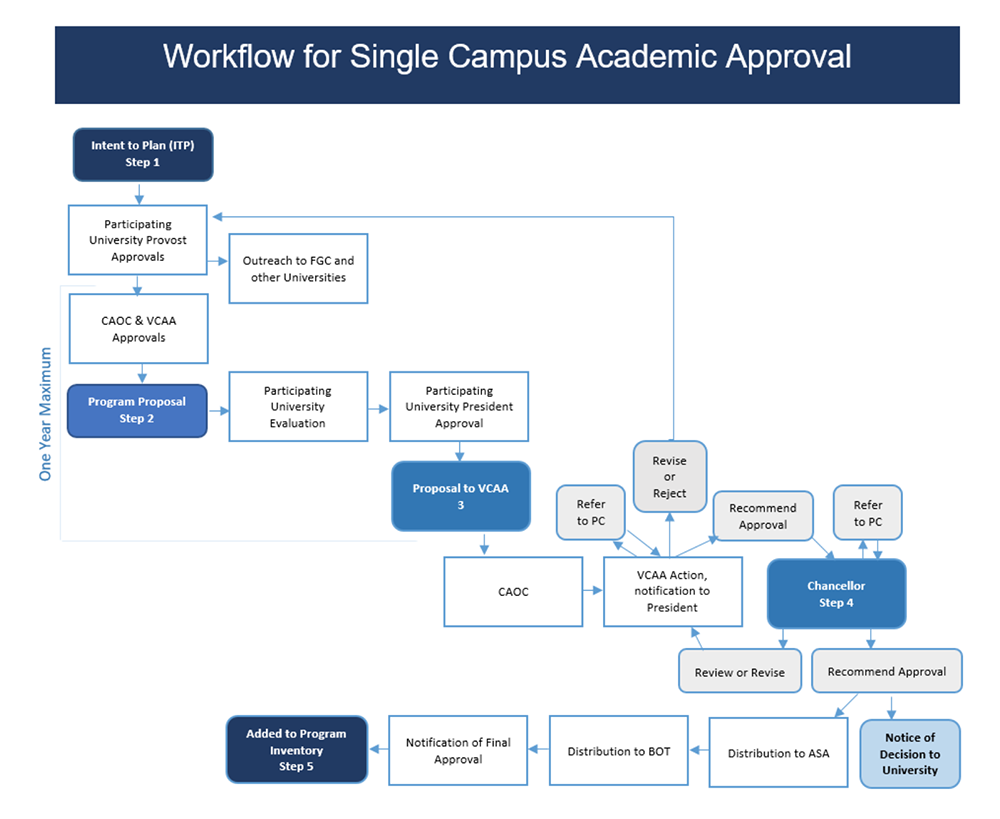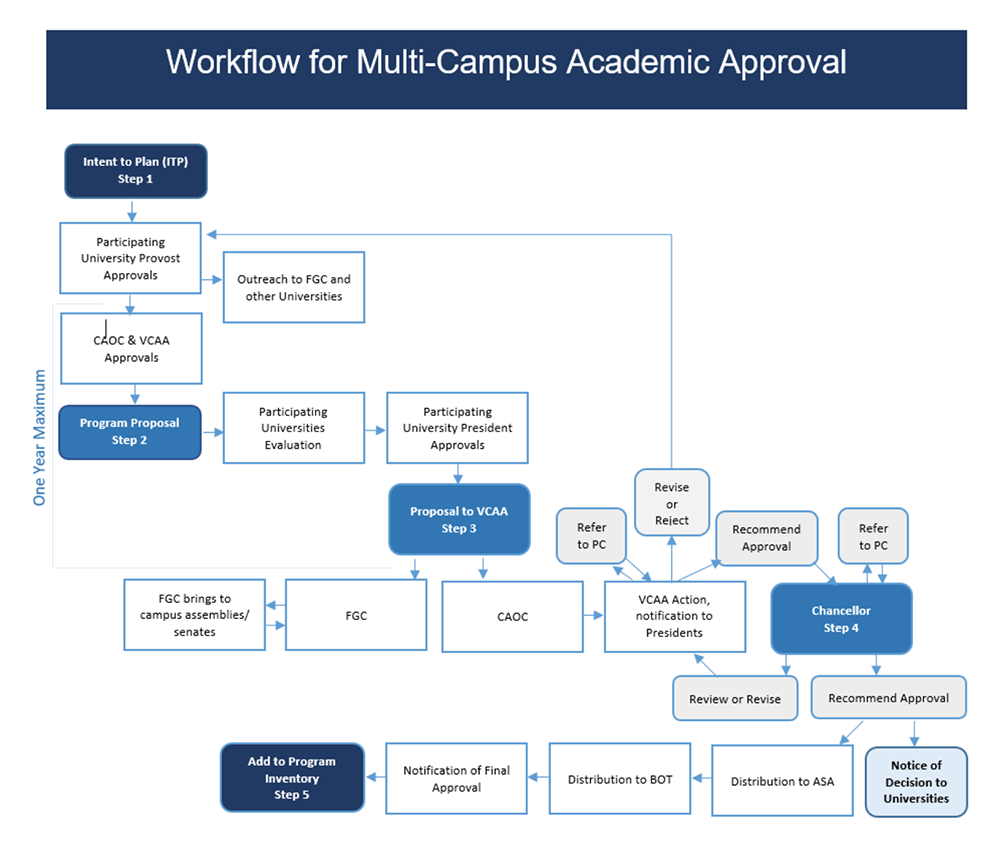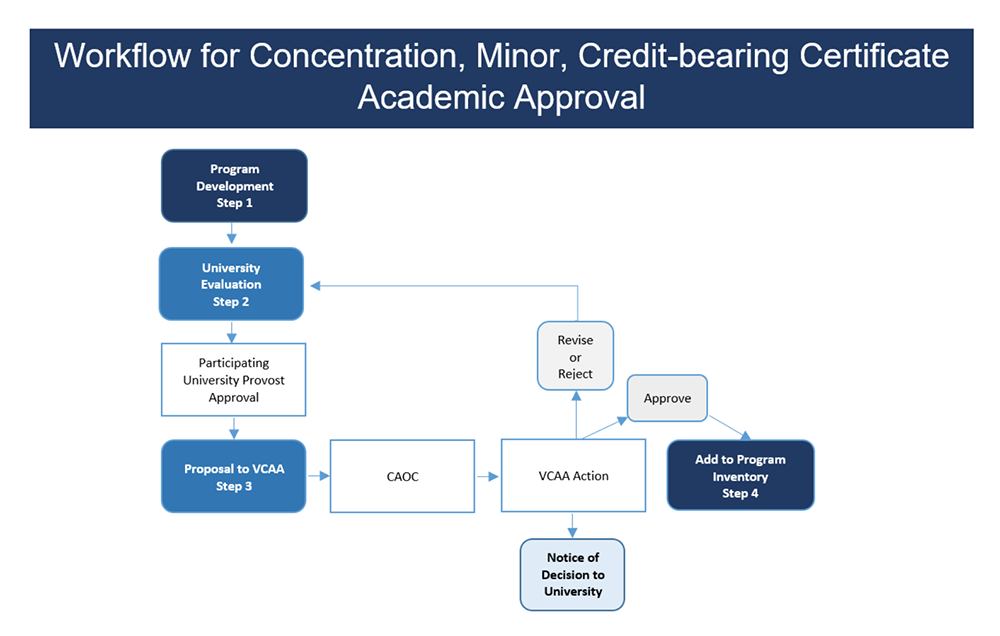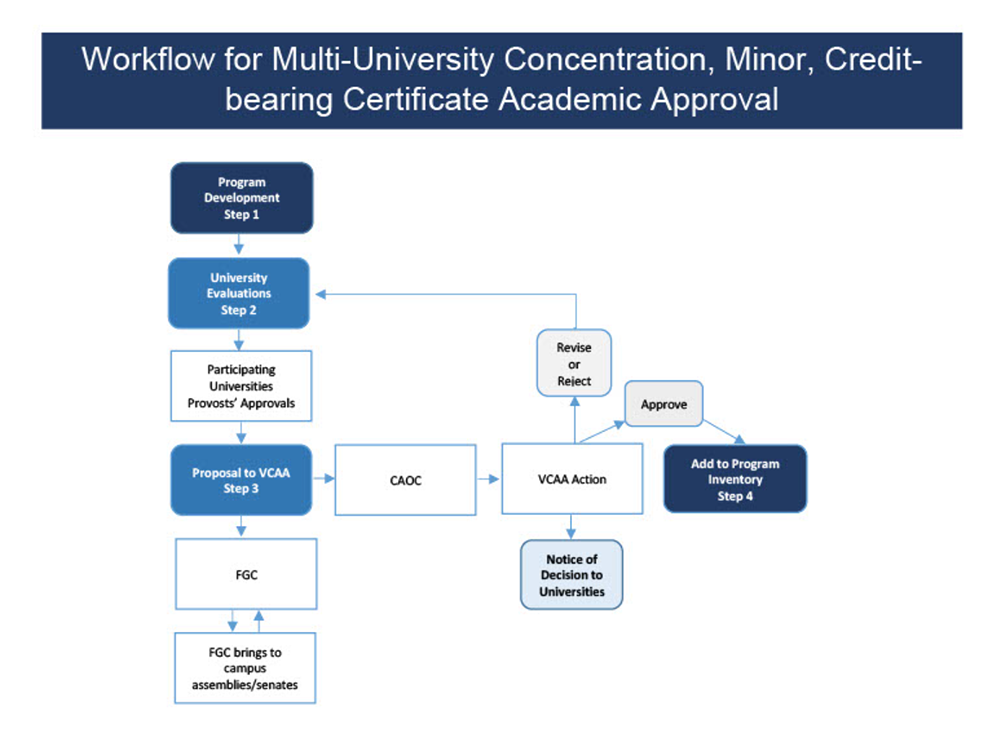Subject: Academic Program Approval
Effective: 1/29/87
Last Revised: 2/25/10, 7/15/19, 5/19/21
Corresponding Policy Manual Link: Section 305.1, Board of Trustees Policy Manual
Purpose Statement
The purpose of this Administrative Practice Letter (APL) is to identify the processes and procedures for the submission and approval of academic programs within a University. Section I outlines the process for a single University’s program approval process for academic majors, graduate degrees, and advanced certificates of study, while Section II outlines the process for multi-university program approvals for academic majors, graduate degrees, and advanced certificates of study. Section III outlines the single university program approval process for minors, associates degrees, and credit-bearing certificates. Section IV outlines the multi-university program approval process for minors, associates degrees, and credit-bearing certificates. Section V outlines the process for temporary program approvals, and section VI describes which types of changes may be made to this APL without approval.
Contents
I. Single University Approval of Undergraduate Majors, Graduate Degree Programs and Certificates of Advanced Study
II. Multi-University Approval of Undergraduate Majors, Graduate Degree Programs and Certificates of Advanced Study
III. Single University approval of Concentrations, Minors and Credit Bearing Certificates
IV. Multi-University Approval of Concentrations, Minors and Credit Bearing Certificates
V. Temporary Program Approval
VI. Changes Without Approval
Academic Program Development
Academic units are encouraged to develop innovative programming (e.g., undergraduate majors, graduate degree programs, advanced certificates of study, concentrations, minors, associate degrees, or credit-bearing certificates) that balances the inventory at each University in order to provide students with flexible choices while allowing the University of Maine System to strategically respond to statewide and regional workforce needs under Unified Accreditation.
I. Single University Approval of Undergraduate Majors and Graduate Degree Programs

Click here to view Text-Only Description of Workflow for Single Campus Academic Approval Flowchart
Step 1: Intent to Plan (ITP)
An Intent to Plan (ITP) will be submitted to the University Provost with a written description and rationale for a new program in 500 words or less. The ITP must briefly address the following areas:
- general objective of the proposal and how it supports the mission of the university
- evidence of need supported by market analysis
- involvement of universities with similar programming
- extent of support presently available and/or new costs required
- timeline
Upon approval by the Provost, the ITP and accompanying letter of Provost support is provided electronically to the VCASA. The VCASA office will add the ITP to the next Chief Academic Officers Council (CAOC). The VCASA will confirm each Provost’s support or opposition. With consideration of the input of the CAOC, the VCASA approves or does not approve, the advancement of the plan. VCASA office will notify the Provost of the decision. The Provost should notify the Faculty Senate/Assembly President and other relevant campus colleagues of the ITP decision.
Step 2: Development of Program Proposal
Upon approval of an ITP from the VCASA office, a Program Proposal will be prepared and evaluated through the university’s normal curricular process(es). After completion of the program proposal, the university-level evaluation is initiated by the distribution of the proposal to the university’s normal curricular process. Upon approval, the request is forwarded to the University President (or designee). The Program Proposal must address the following areas:
- program objectives and content;
- program need (to include the detailed findings of the market analysis conducted in consultation with campus or University of Maine System (UMS) institutional researchers or other relevant programmatic information);
- differentiation from similar existing UMS programs or how programs will complement each other;
- availability of resources and finances for sustainable program support;
- outline of the future program evaluation process;
- accommodations for diverse accessibility needs under Americans with Disabilities Act (ADA);
- documentation of the university’s approval process, including letters of support from the university president and provost.
- Pro Forma statement (maintained by the VCASA office)
Note: Program proposals must be submitted to the CAOC within 12 months of ITP approval, after which time the request process must be restarted. Submission to the University Curriculum Committee within six months is highly recommended to provide an adequate amount of time for University evaluation.
Step 3: University of Maine System (UMS) Evaluation
After campus approval of the new program proposal, the University of Maine System (UMS) review is initiated by submission of the proposal by the University President (or designee) to the Vice Chancellor for Academic and Student Affairs (VCASA), who will acknowledge receipt of the document and distribute the proposal electronically to members of the CAOC. The CAOC will review and discuss the proposed program at the first available CAOC meeting. After CAOC review, the VCASA has five action options:
- forward the proposal with a recommendation for approval to the Chancellor;
- refer the discussion of the program proposal to the President’s Council;
- seek external review from disciplinary experts;
- return the proposal to the originating university with specific critiques and suggestions for revision; or
- return the proposal to the initiating university with specific written rationale for its rejection.
Should revisions be required by the VCASA, the revised program proposal must be returned to the University for reevaluation. The revised proposal must be returned to the Vice Chancellor for Academic and Student Affairs at least 30 days before the UMS Board of Trustees meeting at which the proposal is to be considered.
The VCASA will notify the University President of the action taken.
Step 4: Chancellor and BOT Action
Upon the recommendation of the VCASA, the Chancellor will review the program proposal. The Chancellor has three action options:
- forward the proposal with a recommendation for approval to the Board;
- refer the discussion of the program proposal to the President’s Council;
- return to the VCASA for appropriate corrective action;
The full program proposal will be transmitted to the Board Office. The proposal will first be provided as an action item to the Academic & Student Affairs Committee (ASA) of the BOT. Upon approval, it will be forwarded to the BOT as a consent agenda item. In the event the ASA believes the proposal requires full Board discussion, it will be forwarded as an action item. All materials must be delivered to the VCASA by the appropriate deadline in order to be considered at the Board meetings.
Step 5: Notification and Program Inventory
Notice of final approval of program proposals will be transmitted to the university. After formal notice of approval, the new program is added to the UMS Program Inventory maintained by the VCASA’s office.
II. Multi-University Approval of Undergraduate Majors, and Graduate Degree Programs

Click here to view Text-Only Description of Workflow for Multi-Campus Academic Approval Flowchart
Step 1: Intent to Plan (ITP)
An Intent to Plan (ITP) will be submitted to the Provosts of the participating universities with a written description and rationale for a new program in 500 words or less. The ITP must briefly address the following areas:
- general objective of the proposal and how it supports the missions of the universities involved in the academic collaboration
- evidence of need supported by market analysis
- involvement of universities with similar programming that are not listed as participating in the academic collaboration
- extent of support presently available and/or new costs required
- timeline
Provosts will be responsible for ensuring that outreach to their colleagues is conducted in a timely manner, including, but not limited to outreach to the Faculty Governance Council (FGC).
Step 2: Submission of Program Proposal
After approval of an ITP from the VCASA office, a Program Proposal will be prepared and evaluated through the participating Universities’ normal curricular process(es). After completion of the program proposal, the University-level evaluation is initiated by the distribution of the proposal to the Universities’ normal curricular process. Upon approval, the request is forwarded to the University President (or designee).
The Program Proposal must address the following areas:
- program objectives and content;
- the program need (to include the detailed findings of the market analysis conducted in consultation with campus or UMS institutional researchers or other relevant programmatic information);
- differentiation from similar existing UMS programs or how programs will complement each other;
- the role each participating university has in the collaborative effort;
- availability of resources and finances for sustainable program support;
- outline of the future program evaluation process;
- accommodations for diverse accessibility needs under ADA;
- documentation of the university’s approval process, including letters of support from the university president and provost.
- Pro Forma statement (maintained by the VCASA office)
Note: Program proposals must be submitted to the CAOC within 12 months of ITP approval, after which time the request process must be restarted. Submission to the University Curriculum Committee within six months is highly recommended to provide an adequate amount of time for University evaluation.
Step 3: University of Maine System (UMS) Evaluation
After campus approval of the new program proposal, the University of Maine System (UMS) review is initiated by submission of the proposal by the University Presidents (or designees) to the Vice Chancellor of Academic and Student Affairs (VCASA), who will acknowledge receipt of the document and distribute the proposal electronically to members of the FGC and CAOC. The FGC will deliver the proposal to their respective faculty senates and assemblies to ensure each campus has had an opportunity to review the proposal. The CAOC and FGC will review and discuss the proposed program at their first available meetings. After their review, the VCASA has five action options:
- forward the proposal with a recommendation for approval to the Chancellor;
- refer the discussion of the program proposal to the President’s Council;
- seek external review from disciplinary experts;
- return the proposal to the participating universities with specific critiques and suggestions for revision; or
- return the proposal to the participating universities with a specific written rationale for its rejection.
Should revisions be required by the VCASA, the revised program proposal must be returned to the partnering universities for reevaluation. The revised proposal must be returned to the Vice Chancellor of Academic and Student Affairs at least 30 days before the UMS Board of Trustees meeting at which the proposal is to be considered.
The VCASA will notify the participating university Presidents of the action taken.
Step 5: Chancellor and BOT Action
Upon the recommendation of the VCASA, the Chancellor will review the program proposal. The Chancellor has three action options:
- forward the proposal with a recommendation for approval to the Board;
- refer the discussion of the program proposal to the President’s Council;
- return to the VCASA for appropriate corrective action;
The full program proposal will be transmitted to the Board Office. The proposal will first be provided as an action item to the Academic & Student Affairs Committee (ASA) of the BOT. Upon approval, it will then be forwarded to the BOT as a consent agenda item. In the event the ASA believes the proposal requires full Board discussion, it will be forwarded as an action item. All materials must be delivered to the VCASA by the appropriate deadline in order to be considered at the Board meetings.
Step 6: Notification and Program Inventory
Notice of final approval of program proposals will be transmitted to the originating universities. After formal notice of approval, the new program is added to the UMS Program Inventory maintained through the VCASA’s office.
III. Single University Approval of Concentrations, Minors, and Certificates

Step 1: Program Development
A program concentration, minor, or credit-bearing certificate (CMC) is developed by an academic department in accordance with the University process. The proposal must address the following areas:
- CMC objectives and content;
- availability of resources and finances for sustainable CMC support;
- accommodations for diverse accessibility needs under ADA;
- documentation of the university’s approval process, including letters of support from the university president and provost.
Step 2: University Evaluation
After completion of a program proposal for a new concentration, minor, or credit-bearing certificate, the university-level evaluation is initiated by the distribution of the proposal to the University’s normal curricular process. Upon approval, the Provost will submit it to the VCASA office for discussion at the next regularly scheduled CAOC meeting (typically within two weeks).
Step 3: University of Maine System (UMS) Evaluation
After completion of the campus program evaluation process, the University of Maine System (UMS) evaluation is initiated by submission of the proposal by the University Provost (or designee) to the Vice Chancellor for Academic and Student Affairs, who will acknowledge receipt of the document and distribute the proposal electronically to members of the CAOC. The CAOC will review and discuss the proposed program at the first available CAOC meeting. After CAOC review, the VCASA has four action options:
- approve as written;
- approve with stipulations;
- return the proposal to the originating university with specific critiques and suggestions for revision; or
- return the proposal to the initiating university with a specific written rationale for its rejection.
Should revisions be required by the VCASA, the revised program proposal must be returned to the University for reevaluation.
Note: Programs of this type do not require BOT approval.
Step 4: Notification and Program Inventory
Notice of final approval of program proposals will be transmitted to the university. After formal notice of approval, the new program is added to the UMS Program Inventory maintained by the VCASA’s office.
IV. Multi-University Approval of Concentrations, Minors, and Certificates

Step 1: Program Development
A multi-university program concentration, minor, or credit-bearing certificate (CMC) is developed by the academic departments in accordance with the University processes. The proposal must address the following areas:
- CMC objectives and content;
- availability of resources and finances for sustainable CMC support;
- accommodations for diverse accessibility needs under ADA;
- documentation of the universities’ approval processes, including letters of support from all university presidents and provosts.
Step 2: University Evaluation
After completion of a program proposal for a new concentration, minor, or credit-bearing certificate, university-level evaluations are initiated by the distribution of the proposal to the University’s normal curricular processes. Upon approvals, the Provosts will submit the proposal to the VCASA office for discussion at the next regularly scheduled CAOC meeting (typically within two weeks).
Step 3: University of Maine System (UMS) Evaluation
After campus approval of the new program proposal, the University of Maine System (UMS) review is initiated by submission of the proposal by the University Presidents (or designees) to the Vice Chancellor of Academic and Student Affairs, who will acknowledge receipt of the document and distribute the proposal electronically to members of the FGC and CAOC. The FGC will deliver the proposal to their respective faculty senates and assemblies to ensure each campus has had an opportunity to review the proposal. The CAOC and FGC will review and discuss the proposed program at their first available meetings. After their review, the VCASA has four action options:
- approve as written;
- approve with stipulations;
- return the proposal to the originating universities with specific critiques and suggestions for revision; or
- return the proposal to the initiating universities with a specific written rationale for its rejection.
Should revisions be required by the VCASA, the revised program proposal must be returned to the Universities for reevaluation.
Note: Programs of this type do not require BOT approval.
Step 4: Notification and Program Inventory
Notice of final approval of program proposals will be transmitted to the universities. After formal notice of approval, the new program is added to the UMS Program Inventory maintained by the VCASA’s office.
V. Temporary Program Approval
To meet urgently needed workforce development demand in a university’s immediate catchment area, the VCASA may make exceptions to the above process, with notification to the Chancellor, Board of Trustees, and appropriate stakeholders.
VI. APL changes without Approval
The Vice Chancellor of Academic and Student Affairs will determine if changes to this APL are substantive or non-substantiative. Substantive changes are required to follow the APL revision process. Non-substantiative changes to this APL do not require any review beyond the VCASA. Non-substantiative changes may take many forms, including but not limited to: grammar, links and departmental websites, or contact information
